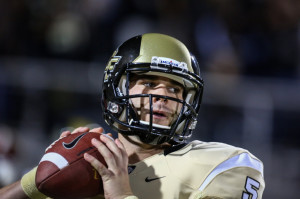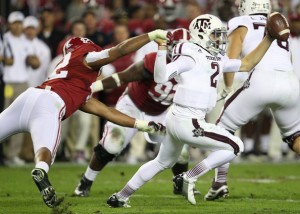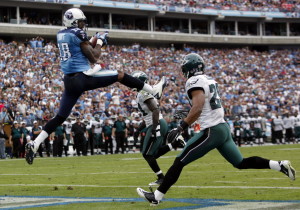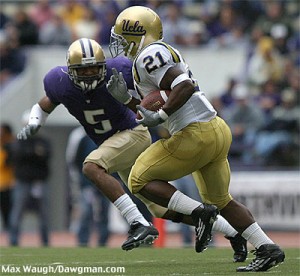One of the most difficult decisions an organization has to make is when to admit its mistakes. The Jaguars drafted Blaine Gabbert with the 10th overall pick in 2011, and his lack of success is even more striking when compared to the rest of the top dozen selections:
Last year, there were three legitimate excuses the Jaguars could proffer to defend Gabbert’s play: he was a rookie, the lockout prevented him from getting proper training, and Jacksonville had the worst set of receivers in the league. Giving up on a first round quarterback after just one season would be silly, especially one where the expectations were that the rookies would struggle. And the cupboard was bare: Jacksonville became the first team since the 2004 Ravens and only the 5th team in the previous 20 seasons to not have a 500-yard wide receiver, so it’s not like Gabbert had a lot to work with.
But through five games, little has changed in Jacksonville. The Jaguars should wait to evaluate Gabbert’s career — five games into his second season isn’t a fair sample size — but his production so far have been extremely disappointing:
A few years ago, Jason Lisk wrote this post on when the Lions should have given upon Joey Harrington. One of the most relevant points of that article was Lisk’s supposition
that teams are far more likely to commit errors of holding on to a quarterback for too long, while rarely giving up on a quarterback too early — once they have seen him play any amount of time in a real NFL game. I can think of examples of quarterbacks who were drafted, never started for their original team, and found success elsewhere, but its relatively rare to find a quarterback who started but never had success with his original team, and moved elsewhere to have his first breakout.
There were 70 quarterbacks selected in the first round of NFL drafts between 1978 and 2010. How often did a team give up too early on a good quarterback? Vinny Testaverde had success outside of Tampa Bay, but the Bucs didn’t give up “early” on him by any means; he played for six years in Tampa with with varying levels of success. The team did give up too early on Steve Young, although he wasn’t included in this study because he was selected in the supplemental draft. Jim Harbaugh had success in Indianapolis, but it’s not like the Bears didn’t know what they had: Harbaugh was in Chicago for the first seven years of his career.
Jeff George had good years outside of Indianapolis, but I wouldn’t say the Colts gave up early on him. He was inconsistent for four years and caused problems off the field; he was finally traded in connection with a holdout. Mike Vick has had success in Philadelphia, but the Falcons obviously had their hands forced when they gave up on him. Ditto Kerry Collins, whose off the field issues left the Panthers with little choice.
With the exception of Steve Young, who Tampa traded after two years — and who may not have ever turned into a star quarterback in Tampa Bay — you’d be hard pressed to find any examples of teams giving up on first round picks too early (with the exception of those released/traded for nonfootball reasons). Chad Pennington had one great year in Miami, but that was after a long career in New York. Doug Williams and Trent Dilfer won Super Bowls with other teams, but Tampa Bay didn’t give up on either quarterback too early by any reasonable definition of the phrase. The reality is, teams will do just about everything before giving up on a first round quarterback too early and as a result, take way too long to move on from a bad investment. And while teams are (understandably) deathly afraid of giving up on a highly drafted quarterback too early, they’re more likely to harm themselves by waiting to move on for too long on a bad investment.
Through six weeks, NFL teams are averaging 6.44 NY/A, meaning Gabbert is averaging only 67% as many net yards per attempt as the average passer. How does that compare historically? The table below shows all drafted quarterbacks who threw at least 250 passes in their second season, and lists their NY/A and NY/A relative to league average during their sophomore years:
If your quarterback plays poorly in his second year, you’re basically hoping he’s Phil Simms (who had his first strong season at age 30) or the good version of Jeff George. Maybe Sam Bradford or [gasp] Tim Tebow, will also become solid starters in the NFL one day. But that’s only one part of the equation, and it’s the minor half. You could have the next Akili Smith or Kyle Boller or David Klingler or Colt McCoy or Rick Mirer or Cade McNown or Joey Harrington, too.
You might think it’s far better to wait a year too long with a first round investment than to cut bait a year too early. Tell that to the Ravens, who after two years of Kyle Boller, chose to wait it out in the 2005 draft and selected Mark Clayton over Aaron Rodgers (why take Rodgers, Cal quarterbacks are terrible!). Detroit selected Joey Harrington with the third pick in the 2002 draft, but as Lisk noted, Detroit could have reasonably “given up” (more on this in a second) on Harrington by the end of the 2003 season. The Lions did not, and selected Roy Williams in the 2004 draft instead of say, Ben Roethlisberger.
And “give up” doesn’t necessarily mean cut or spend a first round pick on another quarterback. Assuming Joe Flacco re-signs with Baltimore, there won’t be any real options in free agency for the Jaguars to address the quarterback position (Jason Campbell is probably the best of the bunch). But they can certainly address the issue in the draft. If a quarterback the Jaguars’ scouts view as elite is available with their (potentially very high) first round pick, then I don’t think you can simply say “let’s give Blaine one more year.” But at a minimum, the Jaguars must spend a pick on a quarterback in the 2013 draft if Gabbert doesn’t improve over the rest of 2012.







